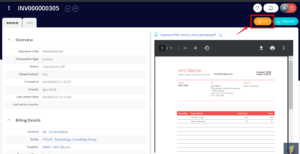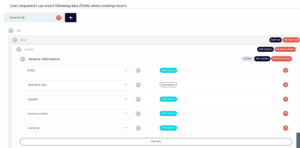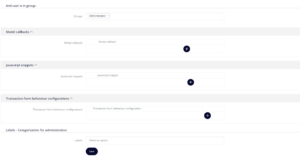
In Edit Permission, you can set up that Users or Groups of Users can edit specific fields through the “Edit” button located on the top right corner of the Transaction regardless of whether the Transaction is assigned to them or not. After the edit, the Transaction’s Status is not changed.

General setup
Name (internal) – mandatory, just an internal name for this particular form that will make the administration of all Edit Permissions readable for other administrators. It should be clear and self-explanatory.
Description – optional, to further describe the purpose of these Permissions for other administrators to better understand them.
Active – if not checked, the Edit Permissions will not be available to Users.
Show validate button? – a button that will run all the validations and callbacks before saving the Transaction.
Definitionable model – mandatory, choose among the options – if you want this to be a form to edit a Transaction, or a record in any of the Definitions.
If conditions are met
In this section, the conditions that must be met in order for Edit Permissions to work are set up. In our example, the only condition is that the Transaction Type must be Invoice. You can select a combination of multiple fields for different situations (e.g. edit only in case of a specific supplier, edit only invoices in specific statuses, etc.).

Which fields can be edited?
In this section, you will design the form and which fields will be available to edit. You can add new tabs, rows, columns, sections, and fields. You can either add only desired fields manually, or you can add all fields possible for a Transaction.
First, you need to add a new tab by clicking on the big ‘plus’ button. When you click on the tab, you need to add at least one new row by clicking on the big “Add row” button. Then you have to add a new column by clicking on the “Add column” button, then “Add section”, and then, finally, you can add new fields. You can add as many tabs, rows, columns, sections, and fields as needed.
Field options – learn more about the options for displaying of the fields in our Data types article.

User is in group
Please specify Users or Groups of Users who can edit the fields.
Additional settings
Model callbacks, Javascript snippets – to add anything to these sections please contact your IT administrator.
Transaction form behaviour configurations – if you want to set up that the certain field in the edit section should only be displayed if certain conditions are met. You can learn more about Form Behaviour Configuration in our next article.
